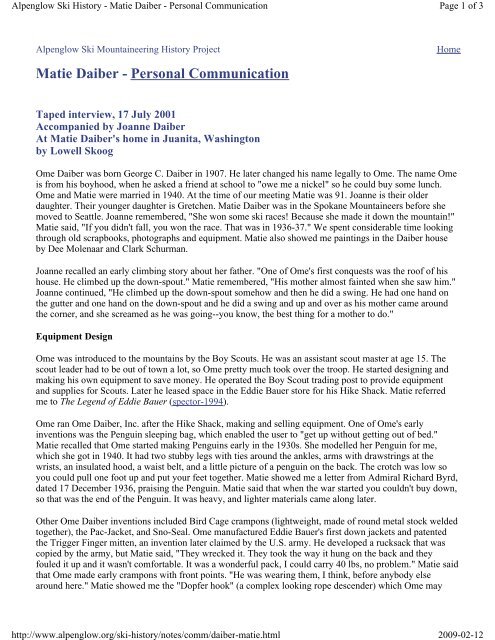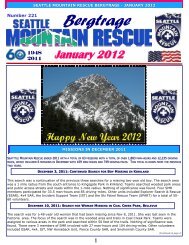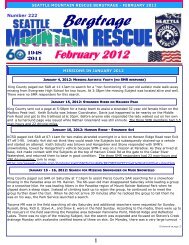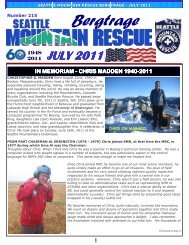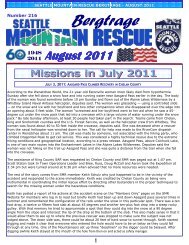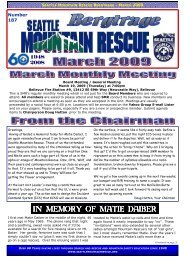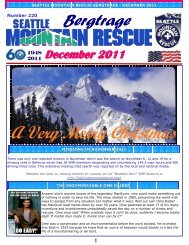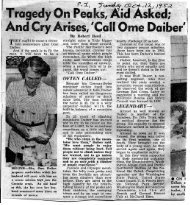Matie Daiber - Personal Communication - Seattle Mountain Rescue
Matie Daiber - Personal Communication - Seattle Mountain Rescue
Matie Daiber - Personal Communication - Seattle Mountain Rescue
You also want an ePaper? Increase the reach of your titles
YUMPU automatically turns print PDFs into web optimized ePapers that Google loves.
Alpenglow Ski History - <strong>Matie</strong> <strong>Daiber</strong> - <strong>Personal</strong> <strong>Communication</strong><br />
Alpenglow Ski <strong>Mountain</strong>eering History Project Home<br />
<strong>Matie</strong> <strong>Daiber</strong> - <strong>Personal</strong> <strong>Communication</strong><br />
Taped interview, 17 July 2001<br />
Accompanied by Joanne <strong>Daiber</strong><br />
At <strong>Matie</strong> <strong>Daiber</strong>'s home in Juanita, Washington<br />
by Lowell Skoog<br />
Ome <strong>Daiber</strong> was born George C. <strong>Daiber</strong> in 1907. He later changed his name legally to Ome. The name Ome<br />
is from his boyhood, when he asked a friend at school to "owe me a nickel" so he could buy some lunch.<br />
Ome and <strong>Matie</strong> were married in 1940. At the time of our meeting <strong>Matie</strong> was 91. Joanne is their older<br />
daughter. Their younger daughter is Gretchen. <strong>Matie</strong> <strong>Daiber</strong> was in the Spokane <strong>Mountain</strong>eers before she<br />
moved to <strong>Seattle</strong>. Joanne remembered, "She won some ski races! Because she made it down the mountain!"<br />
<strong>Matie</strong> said, "If you didn't fall, you won the race. That was in 1936-37." We spent considerable time looking<br />
through old scrapbooks, photographs and equipment. <strong>Matie</strong> also showed me paintings in the <strong>Daiber</strong> house<br />
by Dee Molenaar and Clark Schurman.<br />
Joanne recalled an early climbing story about her father. "One of Ome's first conquests was the roof of his<br />
house. He climbed up the down-spout." <strong>Matie</strong> remembered, "His mother almost fainted when she saw him."<br />
Joanne continued, "He climbed up the down-spout somehow and then he did a swing. He had one hand on<br />
the gutter and one hand on the down-spout and he did a swing and up and over as his mother came around<br />
the corner, and she screamed as he was going--you know, the best thing for a mother to do."<br />
Equipment Design<br />
Ome was introduced to the mountains by the Boy Scouts. He was an assistant scout master at age 15. The<br />
scout leader had to be out of town a lot, so Ome pretty much took over the troop. He started designing and<br />
making his own equipment to save money. He operated the Boy Scout trading post to provide equipment<br />
and supplies for Scouts. Later he leased space in the Eddie Bauer store for his Hike Shack. <strong>Matie</strong> referred<br />
me to The Legend of Eddie Bauer (spector-1994).<br />
Ome ran Ome <strong>Daiber</strong>, Inc. after the Hike Shack, making and selling equipment. One of Ome's early<br />
inventions was the Penguin sleeping bag, which enabled the user to "get up without getting out of bed."<br />
<strong>Matie</strong> recalled that Ome started making Penguins early in the 1930s. She modelled her Penguin for me,<br />
which she got in 1940. It had two stubby legs with ties around the ankles, arms with drawstrings at the<br />
wrists, an insulated hood, a waist belt, and a little picture of a penguin on the back. The crotch was low so<br />
you could pull one foot up and put your feet together. <strong>Matie</strong> showed me a letter from Admiral Richard Byrd,<br />
dated 17 December 1936, praising the Penguin. <strong>Matie</strong> said that when the war started you couldn't buy down,<br />
so that was the end of the Penguin. It was heavy, and lighter materials came along later.<br />
Other Ome <strong>Daiber</strong> inventions included Bird Cage crampons (lightweight, made of round metal stock welded<br />
together), the Pac-Jacket, and Sno-Seal. Ome manufactured Eddie Bauer's first down jackets and patented<br />
the Trigger Finger mitten, an invention later claimed by the U.S. army. He developed a rucksack that was<br />
copied by the army, but <strong>Matie</strong> said, "They wrecked it. They took the way it hung on the back and they<br />
fouled it up and it wasn't comfortable. It was a wonderful pack, I could carry 40 lbs, no problem." <strong>Matie</strong> said<br />
that Ome made early crampons with front points. "He was wearing them, I think, before anybody else<br />
around here." <strong>Matie</strong> showed me the "Dopfer hook" (a complex looking rope descender) which Ome may<br />
http://www.alpenglow.org/ski-history/notes/comm/daiber-matie.html<br />
Page 1 of 3<br />
2009-02-12
Alpenglow Ski History - <strong>Matie</strong> <strong>Daiber</strong> - <strong>Personal</strong> <strong>Communication</strong><br />
have worked on. The word Dopfersicherung was stamped on the metal. She allowed me to borrow and copy<br />
a fascinating booklet full of Ome's patents and unpatented inventions (ocd-inventions).<br />
After World War II began, Ome partnered with Harry Jensen in the <strong>Daiber</strong>-Jensen Company. Stan Sayres<br />
put money into it. Jensen had previously been a salesman for Sayres. Down was reserved for military<br />
production only and was unavailable for civilian use. So <strong>Daiber</strong>-Jensen developed an insulation called<br />
"Jensolite" which was used in sleeping bags. Ome would spend nights in a freezer to test it.<br />
Ome left <strong>Daiber</strong>-Jenson during the war to develop cold weather equipment for the military. He had crushed<br />
his foot in a mountaineering accident when he was younger (I never understood exactly when this happened)<br />
so he was 4-F and could not join the army. He worked at Wright Field in Ohio for six months developing<br />
equipment. <strong>Matie</strong> thought he probably developed a lot of things used by the mountain troops, but she didn't<br />
recall specifics. She showed me a letter from Brig. Gen. S.B. Buckner (in charge of Alaskan defense)<br />
describing equipment requirements for mountain troops in winter.<br />
After the war, Ome got out of equipment manufacturing and became a home-builder. Joanne said he needed<br />
to be doing physical work for health reasons. He built the <strong>Daiber</strong> home (where we met) and homes for Ira<br />
Spring and Tom Hornbein. Joanne remembered, "Tom Hornbein has bits of Ome's fingers in his<br />
foundation." This was literally true, due to an accident with a table saw. Later, Ome struggled with adultonset<br />
diabetes, which settled in his feet. This was not caused by his crushed foot, said Joanne, but it<br />
eventually required amputation of his legs.<br />
<strong>Mountain</strong> <strong>Rescue</strong><br />
When Delmar Fadden was lost on Mt Rainier in the winter 1936, the authorities called Ome for help because<br />
of his Rainier experience, having made the first ascent of Liberty Ridge the previous September. As a result<br />
of this rescue operation, Ome became the go-to man for mountain rescues for many years thereafter. Calls<br />
would come to the <strong>Daiber</strong> house, then <strong>Matie</strong> and Ome would call a list of their mountaineering friends to<br />
help. Ome was therefore a key player when the <strong>Mountain</strong> <strong>Rescue</strong> Council was founded in the late 1940s.<br />
<strong>Matie</strong> showed me Ome's MRC scrapbook (ocd-mrc-scrapbook) containing newspaper clippings about<br />
accidents and MRC members from the 1950s.<br />
Ome was an early member of the National Ski Patrol at Stevens Pass. During World War II, the Ski Patrol<br />
worked in cooperation with the War Department to map mountainous areas for aircraft rescue and civil<br />
defense. Dwight Watson, Dorrell Looff, Ome and others went out every weekend and mapped different<br />
areas. Different men were assigned to each area of the Cascades. <strong>Matie</strong> recalled that they had a stack of<br />
maps in their house at one time. During the war, tires, oil and gas were all rationed so if you had a car break<br />
down during one of these mapping trips, you really had to limp home.<br />
I asked about an incident during the war when a bomber went down in the mountains carrying live bombs<br />
and Ome was called to recover the crew. <strong>Matie</strong> said this occurred in the Olympic <strong>Mountain</strong>s. Joanne said the<br />
military told Ome how to defuse the bombs. <strong>Matie</strong> said Hank Seidelhuber could provide a first-hand account<br />
of that recovery. The military sent men who were experts in such operations and Ome and Hank went along<br />
to provide mountaineering experience. The approached the plane, which was on a steep hillside. According<br />
to <strong>Matie</strong>, the military men "couldn't handle it. [Poor] shoes and the whole thing. So Hank and Ome did the<br />
defusing of the bomb."<br />
Ome got some army surplus skis after World War II, trimmed them down, and skied on them. He always<br />
bored a hole near the tip so he could fasten the skis together if necessary. "He did that early," recalled <strong>Matie</strong>.<br />
She remembered a trip on Mt Rainier that was typical of Ome. He and <strong>Matie</strong> were skiing together, just the<br />
http://www.alpenglow.org/ski-history/notes/comm/daiber-matie.html<br />
Page 2 of 3<br />
2009-02-12
Alpenglow Ski History - <strong>Matie</strong> <strong>Daiber</strong> - <strong>Personal</strong> <strong>Communication</strong><br />
two of them, when they heard somebody calling for help. They investigated and found a lady who said her<br />
friend or husband had been skiing and had broken his leg. Ome took some long thongs and bound the tips of<br />
his skis together using the pre-drilled holes. He made a toboggan this way, padding it with whatever they<br />
had. "We put him on there and Ome splinted him as much as he could," recalled <strong>Matie</strong>. "We used whatever<br />
we had, ski poles I guess. So with that, I remember, I carried a whole armful of skis and poles and stuff and<br />
the two of them (Ome and the woman skier) brought the man down. I wore a bandana, and had others in my<br />
pack, and those became the ties for the splint."<br />
<strong>Matie</strong> and Joanne recommended <strong>Mountain</strong> <strong>Rescue</strong>s by Helen Orlob but did not recommend <strong>Mountain</strong><br />
<strong>Rescue</strong>s with Ome <strong>Daiber</strong> by Richard D. Meyer (privately published in 1966) due to inaccuracies. <strong>Matie</strong><br />
said she had videotapes of two Bob & Ira Spring films, <strong>Mountain</strong>s Don't Care and Skiing Above the Clouds<br />
(spring-movies). I later borrowed these videos from her and still later obtained copies of the films from the<br />
Ira Spring family to transfer them to digital videotape.<br />
Return to the Alpenglow Ski <strong>Mountain</strong>eering History Project home page<br />
Copyright © 2005 Lowell Skoog. All Rights Reserved.<br />
Last Updated: Thu Aug 25 16:09:08 PDT 2005<br />
http://www.alpenglow.org/ski-history/notes/comm/daiber-matie.html<br />
Page 3 of 3<br />
2009-02-12


